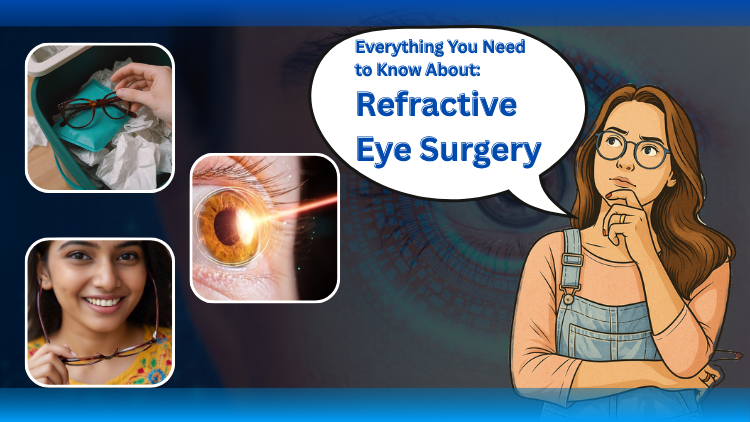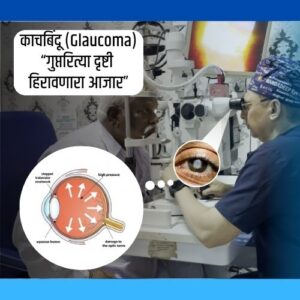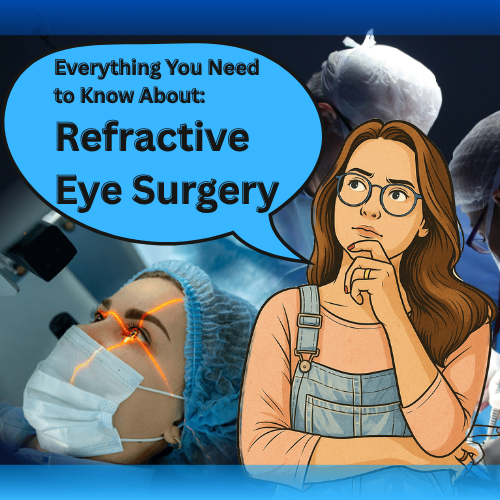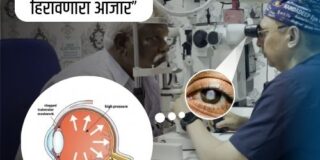Everything You Need to Know About: Refractive Eye Surgery

Refractive eye surgeries are procedures designed to correct common vision problems and reduce or eliminate the need for glasses or contact lenses. Light enters through the cornea and lens in a normal eye, focusing on the retina to create a clear image. When this process is disrupted due to irregularities in the eye’s shape or function, it results in blurry or distorted vision, known as refractive errors.
This blog covers essential information on refractive eye disorders, their causes, treatment options, different types of laser refractive eye surgeries, eligibility criteria, costs in India, and what to expect before and after the procedure.
What is a Refractive Error?
Refractive errors occur when the eye cannot properly focus light on the retina, leading to blurred vision. Common types include:
- Myopia (Nearsightedness) is the difficulty of seeing distant objects clearly, commonly referred to as having a “minus” number.
- Hyperopia (Farsightedness): Difficulty seeing nearby objects; known as having a “plus” number.
- Astigmatism: Caused by an irregular shape of the cornea or lens, leading to distorted or blurred vision at all distances.
- Presbyopia: An age-related condition (usually after 40) in which the eye loses the ability to focus on objects near it due to reduced lens flexibility.
Causes: These issues can arise due to genetic factors, irregular eye shape, or aging. If left uncorrected, refractive errors may lead to headaches, eye strain, and reduced quality of life.
What is Refractive Eye Surgery?
Refractive eye surgery involves reshaping the cornea or replacing the eye’s natural lens to improve the eye’s focusing ability. It aims to correct or significantly reduce refractive errors like myopia, hyperopia, and astigmatism, often eliminating the need for glasses or contact lenses.
Looking for advanced and reliable refractive vision correction? At Nandadeep Eye Hospital, our experienced team uses the latest laser vision correction technology to offer safe, effective, and customized solutions for a wide range of vision problems
Types of Refractive Surgeries
Here are the main types of procedures:
- LASIK (Laser-Assisted In Situ Keratomileusis): A flap is created on the cornea, and the underlying tissue is reshaped using a laser. Offers fast recovery and minimal discomfort. The flap can be made manually or using a femtosecond laser.
- Trans PRK (Transepithelial Photorefractive Keratectomy): The outer corneal layer is removed, and the cornea is reshaped using a laser. Suitable for thinner corneas. Recovery is slightly slower than LASIK.
- SMILE (Small Incision Lenticule Extraction): A minimally invasive, flapless technique where a small tissue lenticule is removed through a tiny incision. Offers fast recovery and less dryness post-surgery.
- Phakic IOL (Implantable Collamer Lens): An artificial lens is implanted between the cornea and the natural lens. Ideal for high refractive errors or patients unsuitable for laser procedures.
- RLE/CLE (Refractive Lens Exchange / Clear Lens Extraction): The natural lens is replaced with an artificial intraocular lens, often used for presbyopia or early cataracts.
Eligibility Criteria
Ideal candidates for refractive surgery:
- Are 18 years or older
- Have had a stable eyeglass prescription for at least one year
- Have healthy corneas and no major eye conditions.
People with keratoconus, severe dry eyes, autoimmune disorders, or uncontrolled diabetes may not be eligible. Pre-operative assessments, including corneal topography and eye health evaluations, are vital to determine suitability.
What to Expect: Before, During, and After Surgery
- Before Surgery: A thorough consultation and eye tests will be conducted to confirm your eligibility and decide the most appropriate procedure.
- During Surgery: The procedure is painless, thanks to numbing eye drops. It takes around 5–15 minutes per eye. You may feel slight pressure or light sensations.
- After Surgery: Vision may be blurry initially. Doctors will advise avoiding eye rubbing, using medicated drops, and protecting your eyes from dust and water. Most people see significant improvement within a day or two, although full stabilisation may take several weeks.
Risks and Side Effects
Refractive surgeries are generally safe with high success rates, but some temporary or minor issues may include:
- Dry eyes
- Glare or halos, especially at night
- Fluctuating or blurry vision
- Mild discomfort or itching during recovery
Serious complications are rare when surgery is performed by an experienced ophthalmologist. That’s why pre-operative evaluations are essential.
Cost of Refractive Eye Surgery in India
The cost varies depending on the type of surgery, equipment used, surgeon expertise, and location:
- Approximate range: ₹30,000 to ₹1,50,000 per eye
- Financing options: Many hospitals offer EMI or easy payment plans
- Note: Prices are generally higher in metro cities and premium eye centres
Choosing the Right Eye Surgeon or Hospital
Here’s what to look for:
- Board-certified and experienced ophthalmologists
- NABH-accredited hospitals or clinics
- Advanced laser technologies like femtosecond lasers and wavefront mapping
- Good patient reviews and a strong track record of successful outcomes.
Schedule a detailed consultation to clarify doubts and align expectations.
FAQS About Refractive Eye Surgery
Q: Is the surgery painful?
No. Numbing eye drops are used. You may feel slight pressure, but no pain.
Q: Will I need glasses again?
Most patients enjoy long-term freedom from glasses. However, age-related conditions like presbyopia may require reading glasses later in life.
Q: Can both eyes be treated at once?
Yes, both eyes are usually treated in the same session for convenience.
Q: When can I resume work or drive?
Most people return to work in 1–2 days. You can drive once your doctor confirms your vision is stable.
Q: Are the results permanent?
Yes, but natural ageing processes may still affect your vision over time.
Q: Is it suitable for everyone?
Not for individuals with unstable prescriptions, active eye diseases, or certain health conditions like autoimmune disorders.
Conclusion
Refractive eye surgery is a safe, effective, and life-enhancing option for individuals seeking freedom from glasses or contact lenses. With advances in laser technology and expert surgical care, most patients experience excellent results and high satisfaction.
Ready to take the next step toward a clear vision? Book a consultation with our eye care experts today!
More Posts

Everything You Should Know About Pediatric Eye Exams

काचबिंदू (Glaucoma): नियमित नेत्रतपासणी का आवश्यक आहे?







